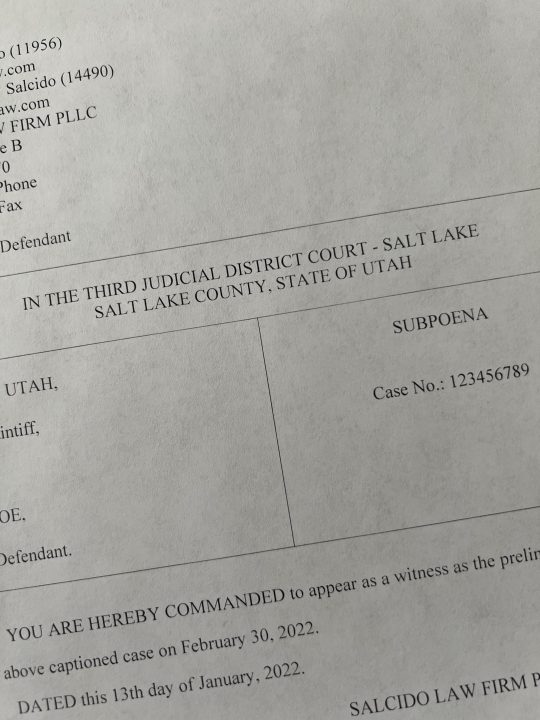Utah Spice Lawyer
Since before “spice” was first banned in Utah Salcido Law Firm has been on the forefront of defending individuals against Criminal Defense. Spice is not a single substance but is the name given to many different products that contain a myriad of different chemical substances. Those substances are listed in the Utah Code and they change annually as the Legislature meets and decides that other products are being used in “spice” products. As of the writing of this post the following products (and their analogs, homologs, and synthetic equivalents) are considered illegal controlled substances.
- AM-694; 1-[(5-fluoropentyl)-1H-indol-3-yl]-(2-iodophenyl)methanone;
- AM-2201; 1-(5-fluoropentyl)-3-(1-naphthoyl)indole;
- CP 47,497 and its C6, C8, and C9 homologs; 2-[(1R,3S)-3-hydroxycyclohexyl] -5-(2-methyloctan-2-yl)phenol;
- Fluoromethcathinone;
- HU-210; (6aR,10aR)-9-(hydroxymethyl)-6,6-dimethyl-3-(2-methyloctan-2-yl) -6a,7,10,10a-tetrahydrobenzo[c]chromen-1-ol;
- HU-211; Dexanabinol,(6aS,10aS)-9-(hydroxymethyl)-6,6-dimethyl-3-(2-
- methyloctan-2-yl)-6a,7,10,10a-tetrahydrobenzo[c]chromen-1-ol;
- JWH-015; (2-methyl-1-propyl-1H-indol-3-yl)-1-naphthalenyl-methanone;
- JWH-018; Naphthalen-1-yl-(pentylindol-3-yl)methanone {also known as 1-Pentyl-3-(1-naphthoyl)indole};
- JWH-019; 1-hexyl-3-(1-naphthoyl)indole;
- JWH-073; Naphthalen-1-yl(1-butylindol-3-yl)methanone {also known as 1-Butyl-3-(1-naphthoyl)indole};
- JWH-081; 4-methoxynaphthalen-1-yl-(1-pentylindol-3-yl)methanone;
- JWH-122; CAS#619294-47-2; (1-Pentyl-3-(4-methyl-1-naphthoyl)indole);
- JWH-200; 1-(2-(4-(morpholinyl)ethyl))-3-(1-naphthoyl)indole;
- JWH-203; 1-pentyl-3-(2-chlorophenylacetyl)indole;
- JWH-210; 4-ethyl-1-naphthalenyl(1-pentyl-1H-indol-3-yl)-methanone;
- JWH-250; 1-pentyl-3-(2-methoxyphenylacetyl)indole;
- JWH-251; 2-(2-methylphenyl)-1-(1-pentyl-1H-indol-3-yl)ethanone;
- JWH-398; 1-pentyl-3-(4-chloro-1-naphthoyl)indole;
- RCS-4; 1-pentyl-3-(4-methoxybenzoyl)indole;
- RCS-8; 1-(2-cyclohexylethyl)-3-(2-methoxyphenylacetyl)indole {also known as BTW-8 and SR-18};
- 4-methylmethcathinone {also known as mephedrone};
- 3,4-methylenedioxypyrovalerone {also known as MDPV};
- 3,4-Methylenedioxymethcathinone {also known as methylone}; and
- 4-methoxymethcathinone.
Most of the substances listed above are what are considered to be synthetic cannaboids. It affects the cannaboid receptor in the human body and can result in a similar high as to that given when smoking marijuana. A lot of the listed substances can be found in products that are sold in common smoke shops. The problem is that both buyers and sellers of such products do not know that some of the products contain banned substances, and the only way one can know that such products are being used is if there is a lab report from a lab that can actually test for such substances.
Distribution and Possession of Spice
Criminal charges involving spice generally involve either the distribution or the possession of a product containing one of the above listed chemicals. If it is a distribution charge the state has to show that the defendant knowingly and intentionally distributed one of the substances listed above. If it is a possession charge the state has to show that the defendant knowingly and intentionally possessed the substances without a valid prescription.
We defend individuals charged with spice possession and distribution all over the state. We’re some of the most experienced spice defense lawyers around. Call us at (801) 413-1753 so we can start defending you.




